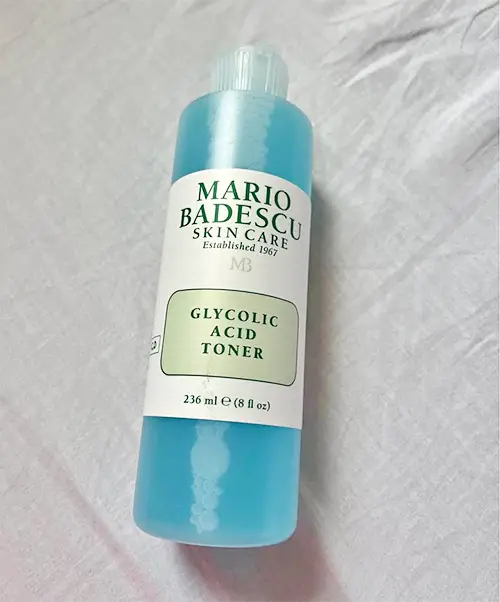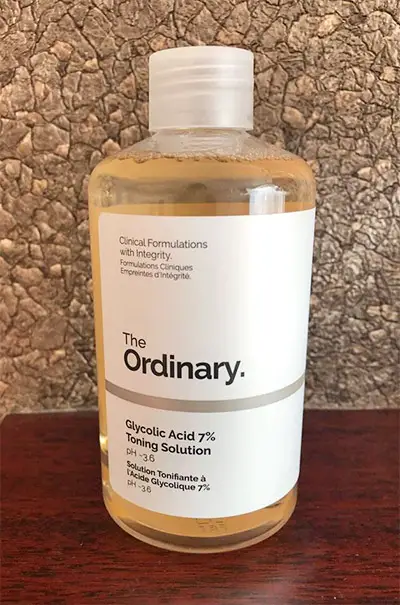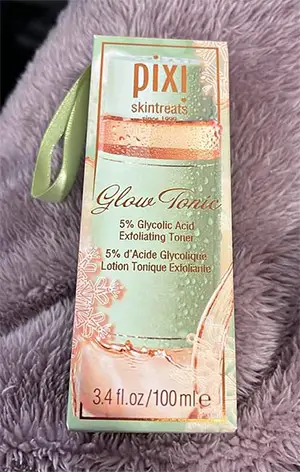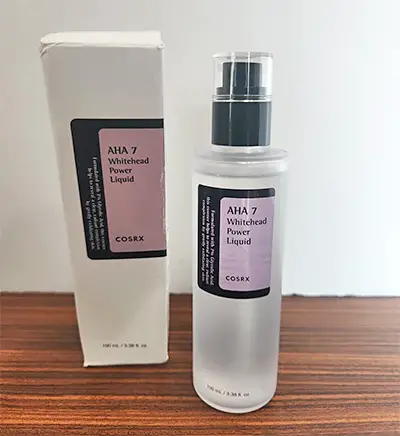In the quest for a more confident and comfortable personal care routine, many people are turning to glycolic acid for solutions. This versatile skincare ingredient has a significant impact on underarm concerns, such as odor and dark pigmentation. This comprehensive guide will delve into the ways glycolic acid could become your go-to for underarm care.
Please note that individual responses to skin care products can vary significantly, so it’s recommended to consult with a healthcare provider or dermatologist before making significant changes to your skincare routine.
Table of Contents
- Understanding Glycolic Acid and Its Uses
- Benefits of Using Glycolic Acid on Underarms
- Glycolic Acid for Underarm Odour
- Glycolic Acid for Dark Underarms
- How to Use Glycolic Acid for Underarms
- Potential Side Effects of Using Glycolic Acid on Armpits
- FAQs
- Best glycolic acid products for underarms
Understanding Glycolic Acid and Its Uses
Glycolic acid, a member of the alpha-hydroxy acid (AHA) family, is derived from sugar cane. Its small molecular size enables efficient skin penetration, promoting exfoliation of the outermost skin layer and encouraging cell renewal beneath. This powerful yet gentle acid can be used on various areas of the body, including the often-overlooked underarms or armpits.
The underarm care application of glycolic acid emerged from a TikTok trend with the hashtag #glycolicacidasdeodorant. Users started replacing their regular deodorants and antiperspirants with glycolic acid and raved about how effective this hack was.
However, it’s important to note that while glycolic acid may help manage underarm odor, it cannot replace an antiperspirant. Antiperspirants work by blocking sweat glands, thus reducing the amount of perspiration produced. Glycolic acid does not have this same function. It can contribute to odor control by reducing bacteria and promoting exfoliation, but it won’t decrease sweat production, an important consideration for individuals prone to excessive perspiration.

Benefits of Using Glycolic Acid on Underarms
Using glycolic acid on underarms can yield several benefits:
Exfoliation
As a chemical exfoliant with keratolytic properties, glycolic acid gently removes dead skin cells, unclogs pores, and smooths your underarm skin. It penetrates the skin’s outermost layer, dissolving the bonds that hold dead skin cells, causing them to shed. This action reveals younger, brighter, and smoother skin. It’s particularly helpful in reducing shaving bumps and any discoloration.
Skin Lightening
The armpit area, prone to constant friction, often darkens over time. Glycolic acid stimulates cell turnover, helping to reduce hyperpigmentation and even out skin tone in the underarm area over time.
Odour Reduction
Glycolic acid’s exfoliating properties and acidic pH help minimize underarm odor by keeping the area clean from dead skin cells and bacteria, often responsible for unpleasant smells.
Glycolic Acid for Underarm Odour
Glycolic acid is not a traditional antiperspirant but can help control odor due to its potent exfoliating properties.
Underarm odor is caused by an enzyme called C-Tylase, which is present in the staphylococcus hominis and coryne bacteria naturally present in our armpits.
These bacteria interact with specific compounds in human sweat, and the C-Tylase enzyme transforms these compounds into thioalcohols – the compound responsible for the pungent smell when we sweat.
Applying glycolic acid to the armpit reduces the buildup of Staphylococcus hominis bacteria and dead skin cells. The acid’s pH makes the underarm environment less conducive for bacteria growth, reducing bad smells.
Internet anecdotal evidence supports the use of glycolic acid for underarm odor, and scientific research aligns with these claims. For instance, a 2013 study indicates that AHAs, such as glycolic acid, can indeed create an environment less favorable for odor-producing bacteria.
Glycolic Acid for Dark Underarms
Glycolic acid is known for brightening skin and treating hyperpigmentation, making it an attractive solution for dark underarms. Its ability to stimulate cell turnover can gradually fade dark patches and create a more even skin tone.
However, be cautious: overuse or a high concentration can cause skin irritation or, paradoxically, exacerbate pigmentation issues.
Also, note that using glycolic acid for your underarms will only be a temporary solution to underarm pigmentation. This is due to the fact that this part of the skin is constantly prone to friction each time you move your arms. This friction is what causes darkening. Once you discontinue the use of glycolic acid, your underarms will eventually darken again.
How to Use Glycolic Acid for Underarms
Before you begin your glycolic acid journey, select a product suitable for your skin type and sensitivity. Glycolic acid can be found in various forms, including creams, toners, and serums. A product with a glycolic acid concentration between 5-10% is a reasonable starting point for most people. Here’s a step-by-step guide on how to use it:
1. Cleanse your underarm area with a gentle, fragrance-free wash, and then pat it dry.
2. Apply a thin layer of your chosen glycolic acid product to the area.
3. Leave the product on your skin for the duration recommended by the manufacturer, typically around 10-20 minutes.
4. Rinse off the product thoroughly with cool water. This is very important as leaving glycolic acid on for too long can trigger burns.
5. Follow up with a hydrating serum or gel-based non-comedogenic moisturizer to keep your skin properly hydrated.
When it comes to frequency, it’s wise to adopt a gradual approach. Begin by applying glycolic acid every other day or even every third day, and monitor your skin’s response.
If your skin tolerates the product well, you can slowly increase the frequency. Make sure to use glycolic acid-based products no more than 3 times a week. Daily use of glycolic acid on the underarms is generally not recommended.
It’s also worth mentioning that glycolic acid can increase the skin’s sensitivity to the sun. This means that even areas like the underarms, which are usually less exposed, could be vulnerable to sun damage if they’re unprotected. Therefore, if you plan to wear clothing that exposes your underarms or partake in activities that could lead to sun exposure, make sure to use sun protection.
Potential Side Effects of Using Glycolic Acid on Armpits
Like any active skincare ingredient, glycolic acid can cause side effects. These might include:
- • Skin redness
- • Tingling sensation
- • Dryness, and increased sensitivity to sun exposure
- • Skin burns in extreme cases
Do not use glycolic acid immediately before and after shaving. This will increase the risk of your skin getting irritated. Always wait a week or two after you shave before applying glycolic acid to your armpits.
To minimize these risks, start with a low concentration, limit the frequency of application, and always use sun protection in areas where glycolic acid has been applied.
If you experience significant discomfort or adverse reactions such as blistering, severe burning, or signs of an allergic reaction like hives, itching, or difficulty breathing, discontinue use and consult a healthcare provider or dermatologist immediately.
Everyone’s skin responds differently, so it’s essential to conduct a patch test before incorporating glycolic acid or any new product into your routine. With the right approach and precautions, glycolic acid could be your key to brighter, fresher, and odor-free underarms.
However, if your skin is very sensitive, exploring alternative options like azelaic acid might be worthwhile. For a comprehensive guide on how azelaic acid can be used for underarms, you might find this article on using azelaic acid for brighter underarms helpful.
FAQs
Can I use deodorant after glycolic acid?
Yes, you can use deodorant after applying glycolic acid. However, ensure you’ve rinsed the acid off thoroughly and your skin is dry before applying deodorant. Waiting for a little while (around 15-30 minutes) before applying deodorant can help prevent possible irritation.
Can I apply glycolic acid daily?
It is generally not recommended to apply glycolic acid daily, especially on sensitive areas like underarms. Start with a frequency of every other day or every third day and increase gradually if your skin tolerates it well. However, do not exceed usage more than three times a week.
Can I use glycolic acid right after shaving?
No, you should not use glycolic acid immediately before or after shaving. This can cause significant skin irritation. It’s best to wait a week or two after shaving before applying glycolic acid to your armpits.
How long does it take for glycolic acid to lighten underarms?
The results may vary from person to person based on skin type, the severity of the discoloration, and the concentration of the glycolic acid used. Generally, some improvement can be noticed after a few weeks of consistent use. However, it’s important to remember that the results are not permanent, and discoloration may return after discontinuing the use of glycolic acid.
Can I use glycolic acid if I have sensitive skin?
If you have sensitive skin, you should start with a low concentration product (like 5%) and use it infrequently (once a week to begin with). It’s also crucial to monitor your skin’s reaction. If you notice any signs of irritation or adverse reactions, discontinue use and consult a dermatologist. Glycolic acid is powerful, and while it can be beneficial, it can also cause issues for sensitive skin if not used cautiously.
Does glycolic acid stop sweat?
No, glycolic acid does not stop sweat. It is not an antiperspirant. It can help manage underarm odor by reducing bacteria and promoting exfoliation, but it will not decrease sweat production.
Best glycolic acid products for underarms
Choosing the right glycolic acid product largely depends on your skin type and the specific skin concerns you wish to address. Here are a few top-rated glycolic acid products suitable for underarm use:
The Ordinary Glycolic Acid 7% Toning Solution: This product is affordable, effective, and contains aloe vera for soothing properties. It’s a great introductory product for those new to glycolic acid.

Pixi Glow Tonic: This gentle toner has 5% glycolic acid. It’s perfect for beginners or those with sensitive skin. It also contains aloe and ginseng to soothe and rejuvenate the skin.

Paula’s Choice Skin Perfecting 8% AHA Gel Exfoliant: This gel formula is easy to apply and contains 8% glycolic acid. It also includes chamomile and green tea to soothe and protect the skin.
Alpha Skin Care Intensive Renewal Serum 14% Glycolic AHA: A higher concentration glycolic acid product, it should be used by those who have already acclimated their skin to glycolic acid. It helps to rejuvenate and smooth skin effectively.
Mario Badescu Glycolic Acid Toner: This mild glycolic acid toner also contains grapefruit and aloe vera, known for their skin brightening and soothing properties.
Cosrx AHA 7 Whitehead Power Liquid: With 7% glycolic acid, this Korean skincare product also contains niacinamide, a skin brightening and barrier-strengthening ingredient.

Related content:
The Ordinary Products for Underarms: A Comprehensive Guide

Petra Nakashian (previously Kravos) is a dedicated natural health and beauty blogger, driven by the loss of her parents to cancer, which led her to meticulously research beauty product ingredients. With over 10 years of experience, her in-depth knowledge has made her a trusted expert in the field. Founder of Be Healthy Now and Green Beauty Talk, Petra recently expanded her expertise with Beauty Insights Hub, exploring a wider range of beauty treatments. Committed to transparency and honesty, her work is a vital resource for navigating the complex world of beauty.

